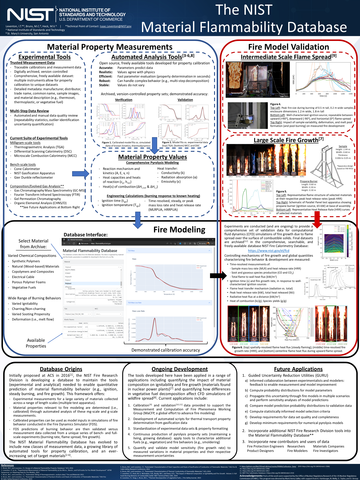Summary
The Material Flammability Characterization project is developing a database (the NIST Material Flammability Database) to maintain the tools (experimental and analytical) needed to enable quantitative prediction of material flammability behavior (e.g., ignition, steady burning, and fire growth). Initially proposed in 2016[1], this framework offers:
- Experimental measurements for a large variety of materials collected across a range of length scales (multiple test apparatus).
- Material properties relevant to fire modeling are determined (i.e., calibrated) through automated analysis of these mg-scale and g-scale measurements.
- Calibrated properties can be used as model inputs in simulations of fire behavior conducted in the Fire Dynamics Simulator (FDS).
The NIST Material Flammability Database has evolved to include new classes of measurement data, a growing library of automated tools for property calibration, and an ever-increasing set of target materials[2-5].
Description
Objective
To develop a database that maintains the tools (experimental and analytical), measurement data (for model calibration and validation), material property sets, and validation data needed to enable quantitative prediction of material flammability behavior (e.g., ignition, steady burning, and fire growth).
Research Plan
The fire modeling community is working to quantitatively predict material flammability behavior (e.g., ignition, burning rate, fire growth). State-of-the-art fire models require input parameters (material properties) that describe: the decomposition reaction mechanism of combustible solids (and associated kinetics and thermodynamics) and relevant heat/mass transport properties.

To address this need, NIST Fire Research Division has been developing[1] experimental and analytical tools to calibrate these material properties and validate their ability to predict flammability response across a range of configurations/scales (i.e., mg-scale thermal decomposition, g-scale gasification/burning, and flame spread over panels 0.5 m to 2.44 m tall).
To date, these tools have been used to characterize synthetic polymers and copolymers, fiber-reinforced composite materials, porous polymer foams, and natural- and engineered-wood-products. These calibration measurements[2,15,16], analysis tools[3-5,11], resulting material property sets, and comparisons of experimental measurements[6] and numerical simulations (Fire Dynamics Simulator, FDS) of full-scale fire growth behavior (model validation) are maintained on the NIST Flammability Database (Fig. 1).
Ongoing Development
The tools developed here have been applied in a range of applications including quantifying the impact of material composition on ignitability and fire growth (materials found in nuclear power plants)[7], quantifying how differences in vegetative fuel decomposition affect CFD simulations of wildfire spread[8], and understanding the flammability performance of products and materials used in wildland urban interface (WUI) homes and communities (noted as a high priority for fire and materials research in a recent road mapping exercise [14].
Current research applications include:
- Calibration[9] and validation[10,11] data provided to support the Measurement and Computation of Fire Phenomena Working Group (MaCFP, a global effort to advance fire modeling)
- Development of automated scripts[13] for thermal transport property determination from gasification data
- Standardization of experimental data sets, material property and model parameter formatting
- Continuous production of pyrolysis property sets (maintaining a living, growing database): apply tools to characterize additional fuels (e.g., vegetation) and fire behaviors (e.g., smoldering)
- Quantify and validate model sensitivity (fire growth rate) to measured variations in material properties and their respective measurement uncertainties
- Determination of material property requirements (for test material replacement) PROJECT POSTER PDF

